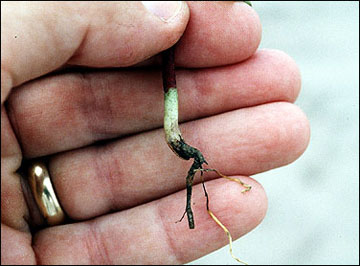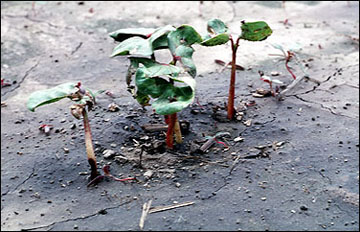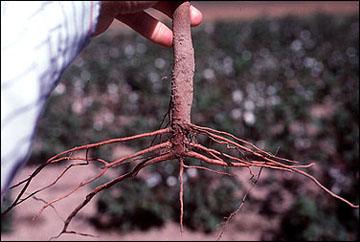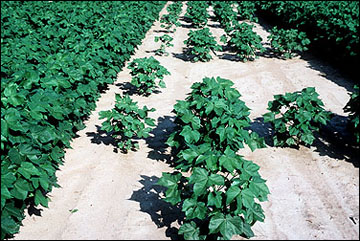What are cotton seedling diseases and what causes them?
Several different, normally harmless, microscopic organisms that live on organic matter in the soil can attack cotton seedling roots in the spring. These organisms are called fungi. The ones most commonly found attacking cotton in Missouri are named Pythium, Fusarium, Rhizoctonia and Thielaviopsis. A plant may be attacked by one of these or by several at the same time. Each of these organisms causes a different disease, and the symptoms are different for each. However, they are collectively known as seedling diseases.
The organisms that cause seedling diseases are present in most soils. Once established, they remain there indefinitely. They produce structures that enable them to survive in the soil from year to year.
Seedling diseases become worse when the soil is cool and most especially when the soil is wet. These conditions do not develop in Missouri every year. Because of yearly variations in weather, the severity of cotton seedling diseases also varies. Cotton seedling diseases cause more yield loss than any other disease in Missouri.
How do cotton seedling diseases damage cotton?
The microscopic organisms that cause seedling diseases penetrate and grow within the cotton root by secreting chemicals that dissolve the root tissue. The organisms absorb the nutrients they need for growth from the damaged root. The root damage may vary from slight injury (which the root may outgrow), to moderate injury (the plant lives but the root is permanently damaged), to seedling death. Diseased roots are unable to absorb water and nutrients as well as a healthy root, and the plant will grow more slowly as a result. Plants with permanently damaged roots usually shed young bolls more quickly during summer drought; they mature later, yield less and produce poorer-quality lint than healthy plants.
What are the symptoms of seedling diseases?
A healthy cotton seedling root is white and firm, and the central root (taproot) is long with numerous secondary white roots emerging from the upper taproot. A stand of healthy cotton seedlings is uniform with no skips. Seedling diseases affect young plants in several ways. Dark, rotten areas (lesions) develop on infected roots (Figure 1). Seedlings may wither and die after the disease kills the root (Figure 2). The taproot may be destroyed, leaving only shallow-growing lateral roots to support the plant (Figure 3). Plants that survive infection are often weak, more susceptible to other diseases and environmental stresses, and unproductive. Sometimes seedling diseases will kill entire fields of young cotton. The most frequent result of this problem is thin, uneven stands of weakened plants (Figure 4) that grow slowly, yield poorly and have low-grade lint.
 Figure 1
Figure 1
Rotten areas on roots damaged by seedling diseases.
 Figure 2
Figure 2
Seedlings damaged or killed by seedling disease.
 Figure 3
Figure 3
Shallow lateral roots left after the tap root has been destroyed by seedling disease.
 Figure 4
Figure 4
A thin, uneven cotton stand due to seedling disease.
What can be done to prevent seedling diseases?
There is no way to eradicate the problem, but the following six steps can be taken to minimize damage:
- Plant only when the soil temperature 4 inches deep has warmed up to about 65 degrees F by 8 a.m. and plant only when five days of warm weather are predicted.
- Plant seeds that germinate quickly and produce vigorous seedlings. There are two germination tests, a warm test and a cool test, that are useful for predicting how a seed lot will perform in the field. In general, the warm germ test (about 86 degrees F) will estimate the percent emergence under highly favorable conditions, while the cool germ test (64 degrees F) will estimate emergence under more typical, somewhat adverse conditions. Minimum acceptable percent germination levels for cotton planting seed are 80 percent on the warm test and 50 percent on the cool test. The warm germination test results are printed on most bags of seed. Growers should ask their seed dealer for the warm and cool germ test results for their planting seed, and should only plant seed that germinates well, especially when planting early or in heavy soil. Fungicide seed treatments on most commercially sold seed are there to protect seed from rot and are very useful.
- Plant in fertile soil. Seedling emergence is retarded in acidic soils (pH less than 5.5) or alkaline soils (pH greater than 7.0) or soils low in phosphorus or potassium. Starved, slow-growing seedlings are more susceptible to damage by seedling diseases. Growers should make sure that soil nutrient levels and pH levels in their fields are adequate for best cotton growth and yield.
- Seedling diseases are worse when the soil is cold and wet. In general, the top of a raised bed is dryer and warmer than flat soil. To minimize seedling disease, plant on raised beds to maximize drainage and the soil temperature of the seedbed. Make sure field drainage is adequate to eliminate excess water quickly, and break hard pans to improve internal drainage.
- When planting early or in poorly drained clay soil, use an in-furrow fungicide for extra protection against organisms that cause seedling diseases. The fungicides applied to seed by the seed supplier help protect the seed and seedling against rot (see Step 2), and farmers may have additional fungicides applied to seed for protection against these diseases especially when planting early or into clay soils. A fungicide applied to seed in the furrow at planting will provide additional protection against seedling diseases. The use of in-furrow fungicides has significantly increased stands in tests conducted at the Delta Center.
- Use a device to move trash away from the row when planting no-till, so the sun will warm the soil around the seed faster.
Following these suggested procedures will give cotton farmers a better chance to produce high yields and profit. More information is available at the MU Delta Center website at http://aes.missouri.edu/delta.